Table of Contents
Indications and Grammar: Eyes and Outstretched fingers in a first generation emerging sign language
John b. Haviland
Improvisation, Interaction and Iteration in the Evolution of Linguistic Structure
Marieke Schouwstra, Yasmin Motamedi, Kenny Smith, Simon Kirby
Conventional Structure from Transformative Actions on Prior Gestures in an Emergent System
Ashley Micklos
Adaptors and the Turn-Taking Mechanism
Przemysław Żywiczyński, Sylwester Orzechowski & Sławomir Wacewicz
Repetitive Mutual Hypothesizing Induces Change of Symbol Systems in Graphical Communication
Kaori Tamura & Takashi Hashimoto
Interaction Alone Cannot Support the Emergence of a Spatial Agreement System in a Paired Interaction Context
Emily Carrigan & Marie Coppola
Communication Without Prior Learning Inhibits the Emergence of Systematic Structure
Catriona Silvey, Molly Flaherty, Susan Goldin-Meadow, Simon Kirby, Kenny Smith
Exploring the Role of Interaction in the Emergence of Linguistic Structure
Vinicius Macuch Silva, Seán Roberts
Indications and Grammar: Eyes and Outstretched fingers in a first generation emerging sign language
John B. Haviland
Abstract:
The natural emergence of language can be observed most prominently in the spontaneous and interactive creation of family and village sign systems These arise in contexts where a sufficient number of deaf children and their caregivers are able to socialize one another into innovative communicative practices, sometimes giving rise to entirely new languages. On the basis of such an emerging sign language from a rural Mexican community, this paper argues that pre- (or non-) linguistic interactive resources involving gaze, pointing, and attention management, form the bases for both turn-taking as a pragmatic achievement and proto-grammatical evidential and affective categories in the new sign language.
Citation:
Haviland, J. (2016) Indications and Grammar: Eyes and Outstretched fingers in a first generation emerging sign language. In S. Roberts & G. Mills (Eds.) Proceedings of EvoLang XI, Language Adapts to Interaction Workshop, 21 March, 2016. Available online: http://evolang.org/neworleans/workshops/papers/LATI_1.html

